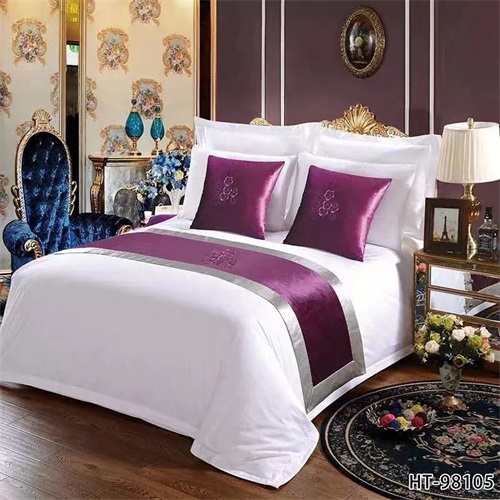手把手教你如何选择酒店布草
时间:2024-03-09 来源:http://www.jnadx.com/
布草主要包含床单、被套、枕套,且与身体皮肤直接接触,直接影响到客人的睡眠及住宿体验,合适的面料既要柔软亲肤,又要光滑美观且要冬天不感到冷,夏天不感到热,还要考虑到使用寿命、性价比以及与酒店定位匹配。选择酒店纺织品看似是复杂的工作,其实是有规律可循的,只要了解清楚材质成份、纱支密度、织物组织及棉纱质量等基本要素,便能较好地选择酒店棉织品的品质。
Linen mainly includes bed sheets, duvet covers, and pillowcases, which come into direct contact with the skin of the body and directly affect the sleep and accommodation experience of guests. The appropriate fabric should be soft and skin friendly, smooth and beautiful, and not feel cold in winter and hot in summer. It also needs to consider service life, cost-effectiveness, and matching with the hotel's positioning. Choosing hotel textiles may seem like a complex task, but there are actually rules to follow. As long as you understand the basic elements of material composition, yarn count density, fabric organization, and cotton yarn quality, you can better choose the quality of hotel cotton textiles.
一、材质的选择
1、 Material selection
1.天然纤维指自然界存在和生长的、具有纺织价值的纤维。天然纤维的种类很多,长期大量用于纺织的有棉、麻、毛、丝四种。蚕丝是天然纤维中的珍贵品种,素称纤维皇后。
1. Natural fibers refer to fibers that exist and grow in nature and have textile value. There are many types of natural fibers, including cotton, linen, wool, and silk, which have been widely used in textiles for a long time. Silk is a precious variety of natural fibers, known as the queen of fibers.
2.化学纤维指用天然的或人工合成的高分子物质为原料,经过化学或物理方法加工而制得的纤维的统称。合成纤维,如涤纶、晴纶等;再生纤维,如粘胶、木浆纤维等。
2. Chemical fibers refer to fibers made from natural or artificially synthesized polymer materials and processed through chemical or physical methods. Synthetic fibers, such as polyester, acrylic, etc; Regenerated fibers, such as viscose, wood pulp fibers, etc.
棉纤维符合各项综合指标,如吸湿性、柔软性、强力等,适宜作为酒店纺织面料。为了兼顾舒适性与耐牢度,可以适当加一些涤含量以增强织物强度,涤的含量宜在20%~50%。
Cotton fibers meet various comprehensive indicators, such as moisture absorption, softness, strength, etc., and are suitable as hotel textile fabrics. In order to balance comfort and durability, it is advisable to add some polyester content to enhance the strength of the fabric. The polyester content should be between 20% and 50%.
二、纱支、密度的选择
2、 Selection of yarn count and density
纱支代表经纬纱线的粗细,是决定面料柔软性、光泽度等的重要指标。
The yarn count represents the thickness of warp and weft yarns and is an important indicator that determines the softness, glossiness, and other properties of the fabric.
1.纱支分为:粗支纱(18s以下)、中支纱(19s~29s)、细支纱(30s~60s)、超细支纱(60s以上)。
1. The yarn count is divided into: coarse count yarn (less than 18s), medium count yarn (19s~29s), fine count yarn (30s~60s), and ultra-fine count yarn (more than 60s).
纱支越高、棉纱越细,手感越柔软、光泽度也更好。细支纱与超细支纱的临界值是 60s ,因此 60s 可以看作重要的参考指标。通过比较,以60s纱为原料织造出来的面料光泽较好、厚薄适中、既兼顾了牢度和舒适性、又兼顾了冬夏的体感,是酒店的合理选择。同时也可以依据此标准结合酒店自身档次进行调整选择一些 60s 及以上的超细支纱。
The higher the yarn count and the finer the cotton yarn, the softer the hand feel and the better the glossiness. The critical value of fine count yarn and ultra-fine count yarn is 60 seconds, so 60 seconds can be regarded as an important reference index. By comparison, the fabric woven from 60s yarn has a better luster, moderate thickness, and combines both firmness and comfort, as well as winter and summer sensations, making it a reasonable choice for hotels. At the same time, based on this standard and in combination with the hotel's own grade, adjustments can be made to select some ultra-fine count yarns with a duration of 60 seconds or more.
2.密度代表经纬纱线的根数,一般来讲,合理的经纬密度配置要符合两点要求。
2. Density represents the number of warp and weft yarns. Generally speaking, a reasonable configuration of warp and weft density should meet two requirements.
A.面料经纬向的强力要接近。相同组织的情况下,不同纱支的面料织物紧度要接近。因此,纱支增高,密度就要相应增大,如:40sx40s140x120与60sx40s173x120。
A. The strength of the fabric in both warp and weft directions should be close. Under the same organization, the tightness of fabrics with different yarn counts should be similar. Therefore, as the yarn count increases, the density should correspondingly increase, such as 40sx40s140x120 and 60sx40s173x120.
B.总的织物紧度需兼顾面料的牢度和手感,符合酒店常用的各类纱支、密度合理的配比。
B. The overall fabric tightness needs to take into account the fabric's fastness and texture, and match the reasonable ratio of various types of yarn counts and densities commonly used in hotels.
三、织物组织的选择
3、 Selection of fabric organization
织物组织代表经、纬纱线交织的方法,是影响面料柔软性、光泽度等的重要指标。织物组织有平纹、斜纹、缎纹、提花的组织。酒店面料使用较多的是平纹、缎纹、提花三种组织。
The method of interweaving warp and weft yarns represented by fabric organization is an important indicator that affects the softness and glossiness of fabrics. Fabric structures include plain weave, twill weave, satin weave, and jacquard weave. The hotel uses three types of fabrics: plain weave, satin weave, and jacquard weave.
1.平纹组织经、纬向交织点多,织物紧密。牢度较好,一般密度较低,成本相对较低,缺点是手感较硬、光泽略差;
1. The plain weave has many interweaving points in the warp and weft directions, and the fabric is tightly woven. Good fastness, generally low density, relatively low cost, but the disadvantage is a hard texture and slightly poor gloss;

2.缎纹组织交织点少,手感柔软、光泽较好,一般密度较高,成本适中;
2. The satin weave has few interweaving points, a soft and glossy texture, generally high density, and moderate cost;
3.提花组织有小提花、大提花之分,成本相对高一些,但装饰性强,可以满足酒店个性化需求。
3. Jacquard organization can be divided into small jacquard and large jacquard, with relatively high costs, but strong decorative properties, which can meet the personalized needs of hotels.
四、棉纱质量的选择
4、 Selection of Cotton Yarn Quality
1.棉纱质量按照纺纱工艺分:精梳、半精梳、普梳棉纱。精梳棉纱是经过梳理机多次梳理后,去除短纤维、杂质,留下较为均匀的长纤维的棉纱,棉纤维排列整齐,表面光滑平整。因此,用精梳棉纱织造出来的面料手感、光泽、强力好,其次是半精梳、普梳。
1. Cotton yarn quality is divided into combed, semi combed, and plain combed cotton yarn according to the spinning process. Combed cotton yarn is a type of cotton yarn that, after being combed multiple times by a carding machine, removes short fibers and impurities, leaving behind relatively uniform long fibers. The cotton fibers are arranged neatly and the surface is smooth and flat. Therefore, fabrics woven from combed cotton yarn have good hand feel, luster, and strength, followed by semi combed and regular combed fabrics.
2.棉纱质量按照纤维长度分:长绒棉、细绒棉、粗绒棉。
2. Cotton yarn quality is divided according to fiber length: long staple cotton, fine staple cotton, and coarse staple cotton.
A.长绒棉的纤维细而长,一般长度在33mm以上,适宜纺60s以上高支纱,用此纤维织出来的面料条干均匀、表面光洁,强力大。
A. The fibers of long staple cotton are thin and long, generally over 33mm in length, suitable for spinning high count yarns for over 60s. The fabric woven with this fiber has uniform evenness, smooth surface, and high strength.
B.细绒棉的纤维长度中等,一般长度在 25mm~33mm,适宜纺60s以下棉纱,但各项指标与长绒棉有差距。
B. The fiber length of fine velvet cotton is moderate, generally ranging from 25mm to 33mm, suitable for spinning cotton yarn for less than 60s, but there are differences in various indicators compared to long staple cotton.
C.粗绒棉的纤维短而粗,一般长度在 23mm以下,适合生产粗厚织物,不宜生产酒店棉织品。
C. Coarse cotton has short and coarse fibers, usually with a length of less than 23mm, suitable for producing thick fabrics and not suitable for producing hotel cotton fabrics.
酒店可以依据自身的需要选择精梳长绒棉、精梳细绒棉、半精梳细绒棉、普梳细绒棉。
Hotels can choose combed long staple cotton, combed fine velvet cotton, semi combed fine velvet cotton, and plain combed fine velvet cotton according to their own needs.
资讯推荐Information
联系我们Information
